Yusuke Oda
Instability in Downstream Task Performance During LLM Pretraining
Oct 06, 2025Abstract:When training large language models (LLMs), it is common practice to track downstream task performance throughout the training process and select the checkpoint with the highest validation score. However, downstream metrics often exhibit substantial fluctuations, making it difficult to identify the checkpoint that truly represents the best-performing model. In this study, we empirically analyze the stability of downstream task performance in an LLM trained on diverse web-scale corpora. We find that task scores frequently fluctuate throughout training, both at the aggregate and example levels. To address this instability, we investigate two post-hoc checkpoint integration methods: checkpoint averaging and ensemble, motivated by the hypothesis that aggregating neighboring checkpoints can reduce performance volatility. We demonstrate both empirically and theoretically that these methods improve downstream performance stability without requiring any changes to the training procedure.
Llama-Mimi: Speech Language Models with Interleaved Semantic and Acoustic Tokens
Sep 18, 2025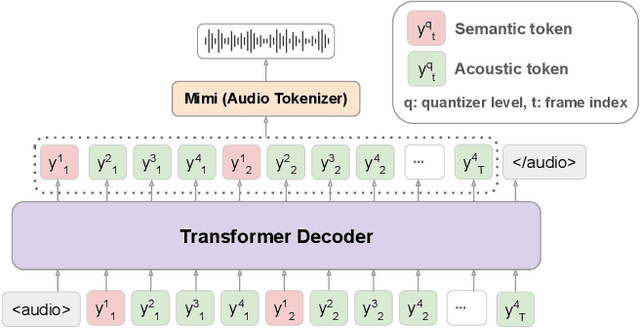


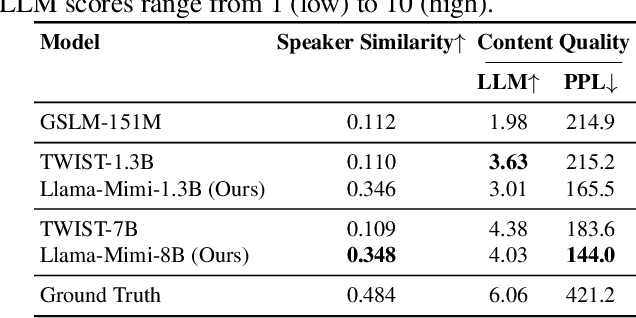
Abstract:We propose Llama-Mimi, a speech language model that uses a unified tokenizer and a single Transformer decoder to jointly model sequences of interleaved semantic and acoustic tokens. Comprehensive evaluation shows that Llama-Mimi achieves state-of-the-art performance in acoustic consistency and possesses the ability to preserve speaker identity. Our analysis further demonstrates that increasing the number of quantizers improves acoustic fidelity but degrades linguistic performance, highlighting the inherent challenge of maintaining long-term coherence. We additionally introduce an LLM-as-a-Judge-based evaluation to assess the spoken content quality of generated outputs. Our models, code, and speech samples are publicly available.
Massive Supervised Fine-tuning Experiments Reveal How Data, Layer, and Training Factors Shape LLM Alignment Quality
Jun 17, 2025Abstract:Supervised fine-tuning (SFT) is a critical step in aligning large language models (LLMs) with human instructions and values, yet many aspects of SFT remain poorly understood. We trained a wide range of base models on a variety of datasets including code generation, mathematical reasoning, and general-domain tasks, resulting in 1,000+ SFT models under controlled conditions. We then identified the dataset properties that matter most and examined the layer-wise modifications introduced by SFT. Our findings reveal that some training-task synergies persist across all models while others vary substantially, emphasizing the importance of model-specific strategies. Moreover, we demonstrate that perplexity consistently predicts SFT effectiveness--often surpassing superficial similarity between trained data and benchmark--and that mid-layer weight changes correlate most strongly with performance gains. We will release these 1,000+ SFT models and benchmark results to accelerate further research.
BIS Reasoning 1.0: The First Large-Scale Japanese Benchmark for Belief-Inconsistent Syllogistic Reasoning
Jun 08, 2025Abstract:We present BIS Reasoning 1.0, the first large-scale Japanese dataset of syllogistic reasoning problems explicitly designed to evaluate belief-inconsistent reasoning in large language models (LLMs). Unlike prior datasets such as NeuBAROCO and JFLD, which focus on general or belief-aligned reasoning, BIS Reasoning 1.0 introduces logically valid yet belief-inconsistent syllogisms to uncover reasoning biases in LLMs trained on human-aligned corpora. We benchmark state-of-the-art models - including GPT models, Claude models, and leading Japanese LLMs - revealing significant variance in performance, with GPT-4o achieving 79.54% accuracy. Our analysis identifies critical weaknesses in current LLMs when handling logically valid but belief-conflicting inputs. These findings have important implications for deploying LLMs in high-stakes domains such as law, healthcare, and scientific literature, where truth must override intuitive belief to ensure integrity and safety.
llm-jp-modernbert: A ModernBERT Model Trained on a Large-Scale Japanese Corpus with Long Context Length
Apr 22, 2025Abstract:Encoder-only transformer models like BERT are widely adopted as a pre-trained backbone for tasks like sentence classification and retrieval. However, pretraining of encoder models with large-scale corpora and long contexts has been relatively underexplored compared to decoder-only transformers. In this work, we present llm-jp-modernbert, a ModernBERT model trained on a publicly available, massive Japanese corpus with a context length of 8192 tokens. While our model does not surpass existing baselines on downstream tasks, it achieves good results on fill-mask test evaluations. We also analyze the effect of context length expansion through pseudo-perplexity experiments. Furthermore, we investigate sentence embeddings in detail, analyzing their transitions during training and comparing them with those from other existing models, confirming similar trends with models sharing the same architecture. To support reproducibility and foster the development of long-context BERT, we release our model, along with the training and evaluation code.
Drop-Upcycling: Training Sparse Mixture of Experts with Partial Re-initialization
Feb 26, 2025Abstract:The Mixture of Experts (MoE) architecture reduces the training and inference cost significantly compared to a dense model of equivalent capacity. Upcycling is an approach that initializes and trains an MoE model using a pre-trained dense model. While upcycling leads to initial performance gains, the training progresses slower than when trained from scratch, leading to suboptimal performance in the long term. We propose Drop-Upcycling - a method that effectively addresses this problem. Drop-Upcycling combines two seemingly contradictory approaches: utilizing the knowledge of pre-trained dense models while statistically re-initializing some parts of the weights. This approach strategically promotes expert specialization, significantly enhancing the MoE model's efficiency in knowledge acquisition. Extensive large-scale experiments demonstrate that Drop-Upcycling significantly outperforms previous MoE construction methods in the long term, specifically when training on hundreds of billions of tokens or more. As a result, our MoE model with 5.9B active parameters achieves comparable performance to a 13B dense model in the same model family, while requiring approximately 1/4 of the training FLOPs. All experimental resources, including source code, training data, model checkpoints and logs, are publicly available to promote reproducibility and future research on MoE.
LLM-jp: A Cross-organizational Project for the Research and Development of Fully Open Japanese LLMs
Jul 04, 2024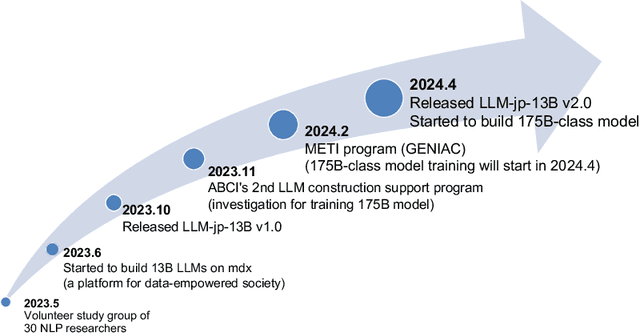
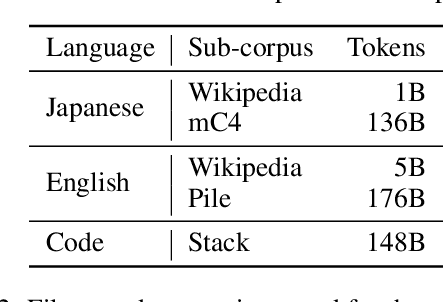


Abstract:This paper introduces LLM-jp, a cross-organizational project for the research and development of Japanese large language models (LLMs). LLM-jp aims to develop open-source and strong Japanese LLMs, and as of this writing, more than 1,500 participants from academia and industry are working together for this purpose. This paper presents the background of the establishment of LLM-jp, summaries of its activities, and technical reports on the LLMs developed by LLM-jp. For the latest activities, visit https://llm-jp.nii.ac.jp/en/.
Vaporetto: Efficient Japanese Tokenization Based on Improved Pointwise Linear Classification
Jun 24, 2024Abstract:This paper proposes an approach to improve the runtime efficiency of Japanese tokenization based on the pointwise linear classification (PLC) framework, which formulates the whole tokenization process as a sequence of linear classification problems. Our approach optimizes tokenization by leveraging the characteristics of the PLC framework and the task definition. Our approach involves (1) composing multiple classifications into array-based operations, (2) efficient feature lookup with memory-optimized automata, and (3) three orthogonal pre-processing methods for reducing actual score calculation. Thus, our approach makes the tokenization speed 5.7 times faster than the current approach based on the same model without decreasing tokenization accuracy. Our implementation is available at https://github.com/daac-tools/vaporetto under the MIT or Apache-2.0 license.
Refactoring Programs Using Large Language Models with Few-Shot Examples
Nov 20, 2023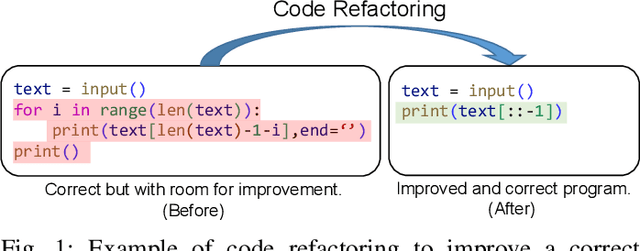



Abstract:A less complex and more straightforward program is a crucial factor that enhances its maintainability and makes writing secure and bug-free programs easier. However, due to its heavy workload and the risks of breaking the working programs, programmers are reluctant to do code refactoring, and thus, it also causes the loss of potential learning experiences. To mitigate this, we demonstrate the application of using a large language model (LLM), GPT-3.5, to suggest less complex versions of the user-written Python program, aiming to encourage users to learn how to write better programs. We propose a method to leverage the prompting with few-shot examples of the LLM by selecting the best-suited code refactoring examples for each target programming problem based on the prior evaluation of prompting with the one-shot example. The quantitative evaluation shows that 95.68% of programs can be refactored by generating 10 candidates each, resulting in a 17.35% reduction in the average cyclomatic complexity and a 25.84% decrease in the average number of lines after filtering only generated programs that are semantically correct. Furthermore, the qualitative evaluation shows outstanding capability in code formatting, while unnecessary behaviors such as deleting or translating comments are also observed.
Exploring the Robustness of Large Language Models for Solving Programming Problems
Jun 26, 2023



Abstract:Using large language models (LLMs) for source code has recently gained attention. LLMs, such as Transformer-based models like Codex and ChatGPT, have been shown to be highly capable of solving a wide range of programming problems. However, the extent to which LLMs understand problem descriptions and generate programs accordingly or just retrieve source code from the most relevant problem in training data based on superficial cues has not been discovered yet. To explore this research question, we conduct experiments to understand the robustness of several popular LLMs, CodeGen and GPT-3.5 series models, capable of tackling code generation tasks in introductory programming problems. Our experimental results show that CodeGen and Codex are sensitive to the superficial modifications of problem descriptions and significantly impact code generation performance. Furthermore, we observe that Codex relies on variable names, as randomized variables decrease the solved rate significantly. However, the state-of-the-art (SOTA) models, such as InstructGPT and ChatGPT, show higher robustness to superficial modifications and have an outstanding capability for solving programming problems. This highlights the fact that slight modifications to the prompts given to the LLMs can greatly affect code generation performance, and careful formatting of prompts is essential for high-quality code generation, while the SOTA models are becoming more robust to perturbations.
 Add to Chrome
Add to Chrome Add to Firefox
Add to Firefox Add to Edge
Add to Edge